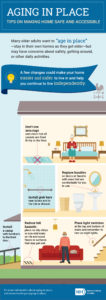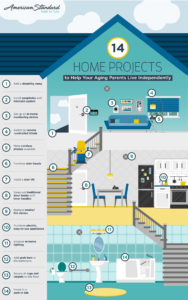In light of the National Senior Independence Month, we asked 15 experts, “What can families do to make sure that their aging loved ones can continue living independently and safely?” We found three common themes: the importance of planning for future care needs early, considering moving them to an independent living community and home modification.
Helpful Insider Tips for National Senior Independence Month

Anthony Cirillo
The most important thing is to discuss the issues early and plan early. You need a plan when you are healthy to avoid disaster when you are not. Start with the legal and financial instruments you need to protect yourself. If you desire to age in place then look at the safety of the home environment especially as it related to slip and fall hazards as well as fire and overall safety issues. It goes without saying that you need to stay healthy with regular exercise and a proper diet in order to thrive as you age. Lastly, make sure wherever you choose to age that there is a social environment where you can meet and interact with others. Without socialization and ongoing purpose, you risk the chance of premature death.

Michelle Seitzer
Talk about end of life decisions together—openly and often. Having an official plan in place should an unforeseen health or housing emergency occur is the best way to ensure that your decisions, your wishes, and your directives are followed and honored. Make this an ongoing conversation, as preferences and plans may change.

Laurie Miller
First, the family should make sure their loved one doesn’t show signs of cognitive or visual impairment which could result in poor decision making or unsafe conditions.
Some signs/cues to look for:
Dirty clothes can be a clue that their loved one may have vision problems and cannot see spots or stains due or it can mean that they just need better lighting in their house.
Unpaid bills, expired food in the refrigerator, not wanting to leave the house alone, not able to make favorite recipes, not able to follow instructions and to forget appointments may be clues of potential cognitive decline and memory concerns. If the family has concerns, they should seek a professional assessment as soon as possible.
Regardless of discovering cognitive decline or not, family members should always be respectful and not tell the loved one what they need to do or not do. They should not treat the aging loved one as a child. They should try their best to engage, have a dialogue and really listen to their loved one.
For example, if driving has become unsafe and the car keys need to taken away, the family should sit down and have a two-way conversation on what to do next. The family needs to listen (and really hear) what their loved one says. The family should explain their concerns of safety not only for their loved one but for other drivers. The family needs to understand and feel empathy that taking car keys away can feel like losing one’s independence and can lead to feelings of isolation of suddenly not being able to jump in a car and go to the store on a whim. The family needs to offer realistic alternatives for their loved one. If Uber or Lyft is a safe option, the family should offer to teach and train them on how to use a ride sharing app. If public transportation is a safe option, the family should go with the senior until they are comfortable on their own with this option. Perhaps hiring a driver or moving to a senior housing that has transportation is an option. Family members must offer an alternative option even if it is the family member themselves offering to drive the senior.
Isolation can quickly become an issue for any senior, healthy and independent or not. Isolation can lead to poor nutrition, depression and feelings of loneliness. Family and friends need to make time to call and visit their aging loved ones. If they feel their loved ones are depressed or isolated, they need to offer positive suggestions and help their loved one find a meaningful activity to do: go to a community or senior center, volunteer at the library or elementary school, visit other seniors in a nursing home, etc. Everyone needs to feel relevant especially our seniors.
Miami Home Care Services
Redesigning the house by making it more accessible is highly recommended. Miami Home Care Services recommends redesigning the house particularly the kitchen. It’s hard for an aging individual to prepare their food, cook and eat if the shelves in the kitchen are stacked high. The best way to resolve this is by putting items that are frequently used on the lower shelves. But not too low that bending is required to access the items. Lowering the counter is also an option to make meal prep possible while sitting down.

My Life Site
My Life Site shared a bold statement, “CCRCs actually enable seniors to live independently for longer.”
Here’s why: CCRCs and other types of retirement communities offer their residents all of the amenities and services needed to allow seniors to care for themselves for as long as possible. But when it comes to CCRCs, they also provide residents with what’s referred to as a continuum of care—the increasing levels of healthcare services that a person may need as they age. Most new residents move into the independent living area of the community, but if any health issues arise, they will be provided assistance with activities of daily living all the way up to skilled nursing care—all within one community.

Daily Caring
Daily Caring recommends joining the Village Movement.
What is a Village Movement?
It is a nationwide network of non-profit membership organizations. Each of these villages helps local seniors to live independently in the comfort of their own home.
How to become a member of the Village Movement?
Those who want to become a member are required to pay a fee for access and to help with services such as household tasks, transportation, handyman services and social activities. The average cost is around $50/month or $600/year.

MomlifeTV
It pays to be observant and vigilant on signs that an aging individual is struggling to carry out daily living activities like cleaning the floor, throwing the garbage, doing the laundry and buying groceries. If you notice dirty floor, empty cupboards, the laundry basket is full and the trash is overflowing, these mean that aging individuals need help in their daily living activities.
Try to understand them first and wait for the perfect moment to raise the issue. Make appropriate suggestions instead of attacking them. Suggest cleaning services, grocery stores that offer home delivery and other services that can help them carry out their daily living activities.

National Institute on Aging
National Institute on Aging (NIH) shared an infographic about tips on how to make aging in place safe and accessible. Here are some of the changes that could make your home easier and safer to live in:
- Refrain from using area rugs
- Replace all handles on faucets and doors that are comfortable to use
- Install grab bars
- Install ramp with handrails
- Reduce fall hazards
- Place light switches at the bottom and top of staircase


WCCO – CBS Minnesota
Most seniors prepare to stay home and age independently. However, almost all houses and apartments are not designed to make it easier and safe for seniors to age in place. Below you can watch Roxana Saberi as she shows everyone how seniors can prepare to live independently at home.

Age Brilliantly
Age Brilliantly shares a comprehensive guide to creating or joining a cohousing project. Senior cohousing is a custom-built neighborhood organized by seniors themselves to fulfill their wants, needs, longevity and quality of life. The guide highlights the importance of senior cohousing:
- Better physical, mental, emotional and spiritual health
- Friendships and accessible social contact
- Safety and security
- Affordability
- Shared resources.

American Standard
Walkintubs.Americanstandard-us.com
American Standard shares home projects that you can do to make sure that your aging parents comfortable and safe as they age in place. These projects can be done DIY or with the assistance of professionals. It’s also important to include them in these home projects by asking them where exactly they want to make changes at home. Here’s an infographic of the list of home modifications or senior living investments that are worth it.


Butler Durrell Security
Technology plays a big part in helping seniors live independently. Smart home systems can make the lives of seniors easier and make them stay at home longer.
Here are some smart home features that are highly recommended by Butler Durrell:
Smart Alerts & Reminders – send text and email reminders to monitor daily living activities and critical events.
Smart Video Systems for Senior Homes – allows you to check on seniors through your smartphone.
Traditional Security and Monitoring – In addition to fire detectors, it is recommended to have a monitored alarm system as well, which calls for immediate help.

AARP
AARP highlights the importance of planning and does it with a perspective of a person who is a fall risk or uses a wheelchair. Here are some of the steps you can do to make it safe for your parent to age in place:
- Ask the help of a professional
- Make home modifications
- Make simple fixes
- Research well
- Stay out of hot water
- Install more lights
- Change the kitchen
- Check alarms
- Stay connected

Right at Home
Right at home are encouraging families to focus on modifications on functional problems of the senior living independently. If the senior has poor eyesight, make changes that are perfect for people with poor vision or if there is a problem in mobility, focus on modifications that makes moving around the house safely.
Here are some home modifications you can consider:
General Household
- Adapt the lower floor of the home for possible one-level living.
Bathroom
- Be sure floor rugs are rubber-backed or secured with double-sided rug tape or rubber carpet mesh.
Bedroom
- Place the bed in a way that allows easy access to the bathroom.
Closets and Cabinets
- Use adjustable rods and shelves in closets and cabinets; consider pullout or pull-down shelves and automatic-close drawers.
Entrance/Exit
- Keep exterior pathways free of holes, loose bricks, uneven pavement, leaves or other tripping/ slipping hazards.
Flooring
- Polish floors with non-glare and non-slippery wax.
Kitchen
- Equip kitchen cabinets with pullout shelves and a Lazy Susan.

Home Security List
We may not have the ability to stop ourselves from getting old or stop physical decline but we can make significant changes to our home environment to making aging and independent living safe and comfortable.
Home Security List offers 25 tips on bathroom, living room, kitchen, home security and monitoring, and bedroom safety that can make the home safe for seniors living independently, which are ready for download. Implementing these tips can vastly improve the safety of aging in place.
These 25 Tips To Make Home Safe For Seniors can be downloaded for free. This free ebook is perfect for people who don’t have the time to read the whole guide right now. They can download the free guide on senior independent living here and read it whenever they are free.

